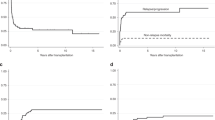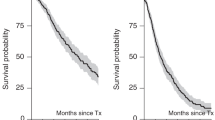Abstract
Between January 1989 and November 1995, 259 patients with multiple myeloma (MM), 22 stage I, 57 stage II and 180 stage III at diagnosis were treated with myeloablative high-dose therapy followed by autologous peripheral blood stem cell (PBSC) transplantation. The median time from diagnosis to transplantation was 17 months (6–112). At the time of transplant, 56 patients were in CR, 153 in PR, 25 were nonresponders and 25 had progressive disease. Mobilization of stem cells was performed with G-CSF alone in 141 cases, chemotherapy plus G-CSF in 65, chemotherapy plus GM-CSF in 36 and chemotherapy alone in 17 patients. The conditioning regimen consisted of high-dose melphalan alone in 96 patients, melphalan plus TBI in 73, busulfan plus melphalan in 56, busulfan plus cyclophosphamide in 27 and cyclophosphamide plus TBI in seven. The median durations of neutropenia (>0.5 × 109/l) and thrombocytopenia (>20 × 109/l) were 12 (5–118) and 13 days (5–360), respectively. Transplant-related mortality occurred in 11 patients (4%). Once a stable graft was achieved, 114 patients (44%) received maintenance treatment with recombinant alpha interferon (IFN-α). Among the 248 patients evaluable for response 125 (51%) had a CR and 100 had a PR (40%). The median duration of progression-free survival (PFS) and overall survival (OS) after transplantation was 23 and 35 months, respectively. Univariate analysis showed that response status pretransplant, only one line of primary induction treatment and IFN-αmaintenance treatment post-transplant significantly influenced OS. Female sex, pretransplant responsive disease, and treatment with IFN-α post-transplant were the factors significantly influencing PFS. The conditioning regimen and method of stem cell mobilization had no significant impact on OS and PFS. On multivariate analysis the only independent factors associated with a longer survival were the number of chemotherapy courses prior to autologous PBSC transplantation and the pretransplant response status. The present analysis from the Spanish Registry confirms the feasibility of autologous PBSC transplantation in myeloma patients with a very low toxicity (4% toxic deaths). The high complete response rate after transplantation is encouraging. The best results are obtained when the procedure is performed early after the first line of induction therapy and in patients with chemosensitive disease. Whether early high-dose therapy followed by autotransplantation in responding patients is superior to conventional chemotherapy is currently being investigated in prospective randomized studies.
This is a preview of subscription content, access via your institution
Access options
Subscribe to this journal
Receive 12 print issues and online access
$259.00 per year
only $21.58 per issue
Buy this article
- Purchase on Springer Link
- Instant access to full article PDF
Prices may be subject to local taxes which are calculated during checkout
Similar content being viewed by others
Author information
Authors and Affiliations
Consortia
Rights and permissions
About this article
Cite this article
Alegre, A., Díaz-Mediavilla, J., San-Miguel, J. et al. Autologous peripheral blood stem cell transplantation for multiple myeloma: a report of 259 cases from the Spanish Registry. Bone Marrow Transplant 21, 133–140 (1998). https://doi.org/10.1038/sj.bmt.1701062
Received:
Accepted:
Published:
Issue Date:
DOI: https://doi.org/10.1038/sj.bmt.1701062
Keywords
This article is cited by
-
Revisiting conditioning dose in newly diagnosed light chain amyloidosis undergoing frontline autologous stem cell transplant: impact on response and survival
Bone Marrow Transplantation (2017)
-
Association of response endpoints with survival outcomes in multiple myeloma
Leukemia (2014)
-
Early response-based intensification of primary therapy in newly diagnosed multiple myeloma patients who are eligible for autologous stem cell transplantation: phase II study
Annals of Hematology (2014)
-
Hepatic veno-occlusive disease after tandem autologous stem cell transplantation conditioned by melphalan
International Journal of Hematology (2008)
-
Sequential, cycling maintenance therapy for post transplant multiple myeloma
Bone Marrow Transplantation (2006)



